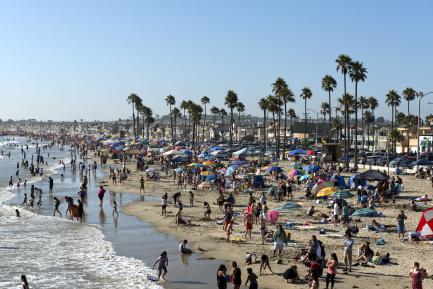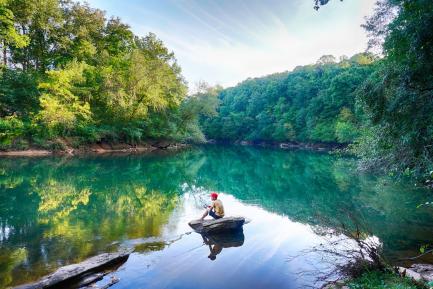Smithsonian Traveling Exhibition Dives Into Water’s Environmental and Cultural Impact
From above, Earth appears as a water planet with more than 71 percent of its surface covered with this vital resource for life. Water impacts climate, agriculture, transportation, industry and more. It inspires art and music. The newest traveling exhibition from the Smithsonian’s Museum on Main Street (MoMS) program, “Water/Ways,” examines water as an environmental necessity and an important cultural element.
A partnership of the Smithsonian Institution Traveling Exhibition Service (SITES) and state humanities councils, MoMS is traveling five copies of “Water/Ways” on simultaneous yearlong tours of Florida, Idaho, Illinois, Minnesota and Wyoming. The exhibition opened May 28 at the Idaho Falls Public Library in Idaho, the Franklin Creek Grist Mill in Franklin Grove, Ill., and the St. Johns River Center in Palatka, Fla. It will open June 25 at the Prairie Woods Environmental Learning Center in Spicer, Minn., and June 27 at Western Wyoming College in Rock Springs. “Water/Ways” will travel to more than 180 small towns across 30 states throughout the next six years. The full tour itinerary can be viewed online at MuseumOnMainStreet.org.
All of the water currently on the planet is all that there will ever be. Through the water cycle it is in endless motion on Earth’s surface, below ground and in the atmosphere. “Water/Ways” explores this cycle, water’s effect on landscape, settlement and migration, and its impact on culture and spirituality. It looks at how political and economic planning have long been affected by access to water and control of water resources. Human creativity and resourcefulness provide new ways of protecting water resources and renewing respect for the natural environment.
Designed for small-town museums, libraries and cultural organizations, “Water/Ways” will serve as a community meeting place to convene conversations about water’s impact on American culture. With the support and guidance of state humanities councils, these towns will develop complementary exhibits, host public programs and facilitate educational initiatives to raise people’s understanding about what water means culturally, socially and spiritually in their own community.
The exhibition will be accompanied by the launch in July 2016 of a redesigned MoMS website—MuseumonMainStreet.org—that will serve as a gateway to share resources from the Smithsonian and other organizations focusing on water issues. The site will also feature a story collection campaign geared to American’s water heritage.
“Water/Ways” is part of the Smithsonian’s Think Water Initiative to raise awareness of water as a critical resource for life through exhibitions, educational resources and public programs. The public can participated in the conversation on social media at #thinkWater.
“Water/Ways” was inspired by an exhibition organized by the American Museum of Natural History, New York (www.amnh.org), and the Science Museum of Minnesota, St. Paul (www.smm.org), in collaboration with Great Lakes Science Center, Cleveland; The Field Museum, Chicago; Instituto Sangari, Sao Paulo, Brazil; National Museum of Australia, Canberra; Royal Ontario Museum, Toronto, Canada; San Diego Natural History Museum; and Science Centre Singapore with PUB Singapore.
MoMS was created to serve museums, libraries and historical societies in rural areas, where one-fifth of all Americans live. The partnership with the state humanities councils was formed as a creative response to the challenge faced by these rural museums to enhance their own cultural legacies. Major funding for MoMS has been provided by the U.S. Congress.
State humanities councils located in each state and U.S. territory support community-based humanities programs that highlight such topics as local history, literature and cultural traditions.
SITES has been sharing the wealth of Smithsonian collections and research programs with millions of people outside Washington, D.C., for 65 years. SITES connects Americans to their shared cultural heritage through a wide range of exhibitions about art, science and history, which are shown wherever people live, work and play. For exhibition description and tour schedules, visit https://www.sites.si.edu/s/.
# # #
SI-230-2016
Jennifer Schommer
202-633-3121




